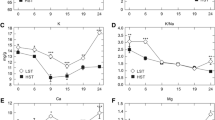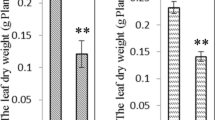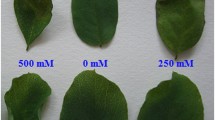Abstract
Leaves are the final site of salinity perception through the roots. To better understand how wheat chloroplasts proteins respond to salt stress, the study aimed to the physiochemical and comparative proteomics analysis. Seedlings (12-days-old) were exposed to 150 mM NaCl for 1, 2, or 3 days. Na+ ions were rapid and excessively increase in roots, stems and leaves. Photosynthesis and transpiration rate, stomatal conductance, and relative water content decreased whereas the level of proline increased. Statistically significant positive correlations were found among the content of hydrogen peroxide, activity of catalase, and superoxide dismutase under salt stress in wheat. Protein abundance within the chloroplasts was examined by two-dimensional electrophoresis. More than 100 protein spots were reproducibly detected on each gel, 21 protein spots were differentially expressed during salt treatment. Using linear quadruple trap-Fourier transform ion cyclotron resonance (LTQ-FTICR) hybrid mass spectrometry, 65 unique proteins assigned in the differentially abundant spots. Most proteins were up-regulated at 2 and 3 days after being down-regulated at 1 day. Others showed only slight responses after 3 days of treatment, including Rubisco, glutamate dehydrogenase, glyceraldehyde-3-phosphate dehydrogenase, isocitrate dehydrogenase, photosystem I, and pyridoxal biosynthesis protein PDX1.2 and PDX1.3. The ATP synthase (α, β, and γ) and V-type proton ATPase subunits were down-regulated resulting showed negative impact by Na+ on the photosynthetic machinery. This ephemeral increase and subsequent decrease in protein contents may demonstrate a counterbalancing influence of identified proteins. Several proteins such as cytochrome b6–f (Cyt b6–f), germin-like-protein, the γ-subunit of ATP synthase, glutamine synthetase, fructose-bisphosphate aldolase, S-adenosylmethionine synthase, carbonic anhydrase were gradually up-regulated during the period of treatment, which can be identified as marker proteins.


Similar content being viewed by others
Abbreviations
- CAT:
-
Catalase
- SOD:
-
Superoxide dismutase
- LTQ:
-
Linear quadruple trap
- FT:
-
Fourier transform
- ICR:
-
Ion cyclotron resonance
References
Quesada V, García-Martínez S, Piqueras P, Pone MR, Micol JL (2002) Genetic architecture of NaCl tolerance in Arabidopsis thaliana. Plant Physiol 130:951–963
Rosenzweig C, Hillel D (2000) Soils and global climate change: challenges and opportunities. Soil Sci 165:47–56
Ghassemi F, Jakeman AJ, Nix HA (1995) Salinization of land and water resources. University of New South Wales Press, Ltd., Canberra
Peng Z, Wang M, Li F, Lv H, Li C, Xia G (2009) A proteomic study of the response to salinity and drought stress in an introgression strain of bread wheat. Mol Cell Proteomics 8:2676–2686
Pérez-López U, Robredo A, Lacuesta M, Sgherri C, Muñoz-Rueda A, Navari-Izzo F, Mena-Petite A (2009) The oxidative stress caused by salinity in two barley cultivars is mitigated by elevated CO2. Physiol Plant 135:29–42
Dooki AD, Mayer-Posner FJ, Askari H, Zaiee AA, Salekdeh GH (2006) Proteomic responses of rice young panicles to salinity. Proteomics 6:6498–6507
Caruso G, Cavaliere C, Guarino C, Gubbiotti R, Foglia P, Laganà A (2008) Identification of changes in Triticum durum L. leaf proteome in response to salt stress by two-dimensional electrophoresis and MALDI-TOF mass spectrometry. Anal Bioanal Chem 391:81–90
Jellouli N, Jouira HB, Daldoul S, Chenennaoui S, Ghorbel A, Salem AB, Gargouri A (2010) Proteomic and transcriptomic analysis of grapevine PR10 expression during salt stress and functional characterization in yeast. Plant Mol Biol Rep 28:1–8
Aghaei K, Ehsanpour AA, Komatsu S (2008) Proteome analysis of potato under salt stress. J Proteome Res 7:4858–4868
Aghaei K, Ehsanpour AA, Shah AH, Komatsu S (2009) Proteome analysis of soybean hypocotyl and root under salt stress. Amino Acids 36:91–98
Razavizadeh R, Ehsanpour AA, Ahsan N, Komatsu S (2009) Proteome analysis of tobacco leaves under salt stress. Peptides 30:1651–1659
Zörb C, Herbst R, Forreiter C, Schubert S (2009) Short-term effects of salt exposure on the maize chloroplast protein pattern. Proteomics 9:4209–4220
Chen M, Shen WB, Ruan HH, Xu LL (2004) Effects of nitric oxide on root growth and its oxidative damage in wheat seedling under salt stress. Zhi Wu Sheng Li Yu Fen Zi Sheng Wu Xue Xue Bao 30:569–576 (article in Chinese)
Yang Y, Xu S, An L, Chen N (2007) NADPH oxidase-dependent hydrogen peroxide production, induced by salinity stress, may be involved in the regulation of total calcium in roots of wheat. J Plant Physiol 164:1429–1435
Shafi M, Bakht J, Hassan MJ, Raziuddin M, Zhang G (2009) Effect of cadmium and salinity stresses on growth and antioxidant enzyme activities of wheat (Triticum aestivum L.). Bull Environ Contam Toxicol 82:772–776
Salekdeh GH, Komatsu S (2007) Crop proteomics: aim at sustainable agriculture of tomorrow. Proteomics 7:2976–2996
Agrawal GK, Jwa NS, Rakwal R (2009) Rice proteomics: ending phase I and the beginning of phase II. Proteomics 9:935–963
Finnie C, Svensson B (2009) Barley seed proteomics from spots to structures. J Proteomics 72:315–324
Blomqvist LA, Ryberg M, Sundqvist C (2006) Proteomic analysis of the etioplast inner membranes of wheat (Triticum aestivum) by two-dimensional electrophoresis and mass spectrometry. Physiol Plant 128:368–381
Blomqvist LA, Ryberg M, Sundqvist C (2008) Proteomic analysis of highly purified prolamellar bodies reveals their significance in chloroplast development. Photosynth Res 96:37–50
Komatsu S, Ahsan N (2009) Soybean proteomics and its application to functional analysis. J Proteomics 72:325–336
Tanaka N, Fujita M, Handa H, Murayama S, Uemura M, Kawamura Y, Mitsui T, Mikami S, Tozawa Y, Yoshinaga T, Komatsu S (2004) Proteomics of the rice cell: systematic identification of the protein populations in subcellular compartments. Mol Genet Genomics 271:566–576
Barrs HD, Weatherley PE (1962) A re-examination of the relative turgidity technique for estimating water deficits in leaves. Aust J Biol Sci 15:413–425
Porra RJ, Thompson WA, Kriedemann PE (1989) Determination of accurate extinction coefficients and simultaneous equations for assaying chlorophylls a and b extracted with four different solvents; verification of the concentration of chlorophyll standards by atomic absorption spectroscopy. Biochim Biophys Acta 975:384–394
Bates L, Waldren RP, Tear IP (1973) Rapid determination of free proline for water stress studies. Plant Soil 39:205–207
Chong TM, Abdullah MA, Fadzillah NM, Lai OM, Lajis NH (2004) Anthraquinones production, hydrogen peroxide level and antioxidant vitamins in Morinda elliptica cell suspension cultures from intermediary and production medium strategies. Plant Cell Rep 22:951–958
Bradford MM (1976) A rapid and sensitive for the quantitation of microgram quantities of protein utilizing the principle of protein-dye binding. Anal Biochem 72:248–254
Baque MA, Lee EJ, Paek KY (2010) Medium salt strength induced changes in growth, physiology and secondary metabolite content in adventitious roots of Morinda citrifolia: the role of antioxidant enzymes and phenylalanine ammonia lyase. Plant Cell Rep 29:685–694
Wu CH, Tewari RK, Hahn EJ, Paek KY (2007) Nitric oxide elicitation induces the accumulation of secondary metabolites and antioxidant defense in adventitious roots of Echinacea purpurea. J Plant Biol 50:636–643
Baque MA, Hahn EJ, Paek KY (2010) Induction mechanism of adventitious root from leaf explants of Morinda citrifolia as affected by auxin and light quality. In Vitro Cell Dev Biol Plant 46:71–80
Kamal AH, Cho K, Komatsu S, Uozumi N, Choi JS, Woo SH (2011) Towards an understanding of wheat chloroplasts: a methodical investigation of thylakoid proteome. Mol Biol Rep. doi:10.1007/s11033-011-1302-4
Kim KH, Kamal AHM, Shin KH, Choi JS, Heo HY, Woo SH (2010) Large-scale proteome investigation in wild relatives (A, B and D genomes) of wheat. Acta Biochim Biophys Sin 42:709–716
O’Farrell PH (1975) High resolution two-dimensional electrophoresis of proteins. J Biol Chem 250:4007–4021
Kim JY, Lee JH, Park GW, Cho K, Kwon KH, Park YM, Cho SY, Paik YK, Yoo JS (2005) Utility of electrophoretically derived protein mass estimates as additional constraints in proteome analysis of human serum based on MS/MS analysis. Proteomics 5:3376–3385
González L, González-Vilar M (2001) Determination of relative water content. In: Roger MJR (ed), Handbook of plant ecophysiology techniques, 1st edn. Kluwer Academic Publishers, Netherland, pp 207–212
Hasegawa PM, Bressan RA, Zhu JK, Bohnert HJ (2000) Plant cellular molecular responses to high salinity. Annu Rev Plant Physiol Plant Mol Biol 51:463–499
Marschner H (1995) Mineral nutrition of higher plants, 2nd edn. Academic Press, London
Allen GJ, Amtmann A, Sanders D (1998) Calcium- dependent and calcium-independent K+ mobilization channels in Vicia faba guard cell vacuoles. J Exp Bot 49:305–318
Solymosi K, Bertrand M (2011) Soil metals, chloroplasts, and secure crop production: a review. Agron Sustain Dev. doi:10.1007/s13593-011-0019-z
Schachtman D, Liu W (1999) Molecular pieces to the puzzle of the interaction between potassium and sodium uptake in plants. Trends Plant Sci 4:281–287
Rengel Z (1992) The role of calcium in salt toxicity. Plant Cell Environ 15:625–632
Kinraide TB (1999) Interactions among Ca2+, Na+ and K+ in salinity toxicity: quantitative resolution of multiple toxic and ameliorative effects. J Exp Bot 50:1495–1505
Zhu JK (2000) Genetic analysis of plant salt tolerance using Arabidopsis. Plant Physiol 124:941–948
El-Shintinawy F (2000) Photosynthesis in two wheat cultivars differing in salt susceptibility. Photosynthetica 38:615–620
Chaves MM, Flexas J, Pinheiro C (2009) Photosynthesis under drought and salt stress: regulation mechanisms from whole plant to cell. Ann Bot 103:551–560
Maathuis FJM (2009) Physiological functions of mineral macronutrients. Curr Opin Plant Biol 12:250–258. doi:10.1016/j.pbi.2009.04.003
Abdelkader AF, Aronsson H, Solymosi K, Böddi B, Sundqvist C (2007) High salt stress induces swollen prothylakoids in dark-grown wheat and alters both prolamellar body transformation and reformation after irradiation. J Exp Bot 58:2553–2564
Dionisio-Sese ML, Tobita S (2000) Effects of salinity on sodium content and photosynthetic responses of rice seedlings differing in salt tolerance. J Plant Physiol 157:54–58
Meloni DA, Oliva MA, Martinez CA, Cambraia J (2003) Photosynthesis and activity of superoxide dismutase, peroxidase and glutathione reductase in cotton under salt stress. Environ Exp Bot 49:69–76
Poustini K, Siosemardeh A, Ranjbar M (2007) Proline accumulation as a response to salt stress in 30 wheat (Triticum aestivum L.) cultivars differing in salt tolerance. Genet Resour Crop Evol 54:925–934
van Heerden PDR, Kruger GHJ (2002) Separately and simultaneously induced dark chilling and drought stress effects on photosynthesis, proline accumulation and antioxidant metabolism in soybean. J Plant Physiol 159:1077–1086
Sharp RE, Hsiao TC, Silk WK (1990) Growth of maize primary root at low water potentials. Plant Physiol 93:1337–1346
Ehsanpour AA, Fatahian N (2003) Effect of salt and proline on Medicago sativa callus. Plant Cell Tissue Organ Cult 73:53–56
Zhang J, Kirkham MB (1994) Drought stress induced changes in activities of superoxide dismutase, catalase, and peroxidase in wheat species. Plant Cell Physiol 35:785–791
Kingston-Smith CAH, Foyer H (2000) Bundle sheath proteins are more sensitive to oxidative damage than those of the mesophyll in sensitive maize leaves exposed to paraquat or low temperatures. J Exp Bot 51:123–130
Yang T, Poovaiah BW (2002) Hydrogen peroxide homeostasis: activation of plant catalase by calcium calmodulin. Proc Natl Acad Sci USA 99:4097–4102
Horton P, Park KJ, Obayashi T, Fujita N, Harada H, Adams-Collier CJ, Nakai K (2007) WoLF PSORT: protein localization predictor. Nucleic Acids Res 35:585–587
Sanders M, Shipkova PA, Zhang H, Warrack BM (2006) Utility of the hybrid LTQ-FTMS for drug metabolism applications. Curr Drug Metab 7:547–555
Yates NA, Deyanova EG, Geissler W, Wiener MC, Sachs JR, Wong KK, Thornberry NA, Roy RS, Settlage RE, Hendrickson RC (2007) Identification of peptidase substrates in human plasma by FTMS based differential mass spectrometry. Int J Mass Spectrom 259:174–183
Jiang Y, Yang B, Harris NS, Deyholos MK (2007) Comparative proteomic analysis of NaCl stress-responsive proteins in Arabidopsis roots. J Exp Bot 57:3591–3607
Holmes-Davis R, Tanaka CK, Vensel WH, Hurkman WJ, McCormick S (2005) Proteome mapping of mature pollen of Arabidopsis thaliana. Proteomics 5:4864–4884
Ndimba BK, Chivasa S, Simon WJ, Slabas AR (2005) Identification of Arabidopsis salt and osmotic stress responsive proteins using two-dimensional difference gel electrophoresis and mass spectrometry. Proteomics 5:4185–4196
Yan SP, Zhang QY, Tang ZC, Su WA, Sun WN (2006) Comparative proteome analysis provides new insights into chilling stress response in rice. Mol Cell Proteomics 5:235–244
Baginsky S, Gruissem W (2002) Endonucleolytic activation directs dark-induced chloroplast mRNA degradation. Nucleic Acids Res 30:4527–4533
Trebitsh T, Danon A (2001) Translation of chloroplast psbA mRNA is regulated by signals initiated by both photosystems II and I. Proc Natl Acad Sci USA 98:12289–12294
Nishikawa M, Hashida M, Takakura Y (2009) Catalase delivery for inhibiting ROS-mediated tissue injury and tumor metastasis. Adv Drug Deliv Rev 61:319–326
Tsugane K, Kobayashi K, Niwa Y, Ohba Y, Wada K, Kobayashi H (1999) A recessive Arabidopsis mutant that grows photoautotrophically under salt stress shows enhanced active oxygen detoxification. Plant Cell 11:1195–1206
Ellis RJ (1979) The most abundant protein in the world. Trends Biochem Sci 4:241–244
Burks EA, Bezerra PP, Le H, Gallie DR, Browning KS (2001) Plant initiation factor 3 subunit composition resembles mammalian initiation factor 3 and has a novel subunit. J Biol Chem 276:2122–2131
Salekdeh GH, Siopongco J, Wade LJ, Ghareyazie B, Bennett J (2002) A proteomic approach to analyzing drought- and salt-responsiveness in rice. Field Crops Res 76:199–219
Hancock JT, Henson D, Nyirenda M, Desikan R, Harrison J, Lewis M, Hughes J, Neill SJ (2005) Proteomic identification of glyceraldehyde 3-phosphate dehydrogenase as an inhibitory target of hydrogen peroxide in Arabidopsis. Plant Physiol Biochem 43:828–835
Ueda A, Kathiresan A, Bennett J, Takabe T (2006) Comparative transcriptome analyses of barley and rice under salt stress. Theor Appl Genet 112:1286–1294
Pang Q, Chen S, Dai S, Chen Y, Wang Y, Yan X (2010) Comparative proteomics of salt tolerance in Arabidopsis thaliana and Thellungiella halophila. J Proteome Res 9:2584–2599
Cushman JC (1993) Molecular cloning and expression of chloroplast NADP-malate dehydrogenase during Crassulacean acid metabolism induction by salt stress. Photosynth Res 35:15–27
Palmgren MG, Harper JF (1999) Pumping with plant P-type ATPases. J Exp Bot 50:883–893
Mansour MMF, Salama KHA, Al-Mutawa MM (2003) Transport proteins and salt tolerance in plants. Plant Sci 164:891–900
Veeranagamallaiah G, Jyothsnakumari G, Thippeswamy M, Chandra Obul Reddy P, Surabhi GK, Sriranganayakulu G, Mahesh Y, Rajasekhar B (2008) Proteomic analysis of salt stress responses in foxtail millet (Setaria italica L. cv. Prasad) seedlings. Plant Sci 175:631–641
Miflin BJ, Habash DZ (2002) The role of glutamine synthetase and glutamate dehydrogenase in nitrogen assimilation and possibilities for improvement in the nitrogen utilization of crops. J Exp Bot 53:979–987
Hodges M, Flesch V, Gálvez S, Bismuth E (2003) Higher plant NADP dependent isocitrate dehydrogenases, ammonium assimilation and NADPH production. Plant Physiol Biochem 41:577–585
Soussi M, Ocaña A, Lluch C (1998) Effect of salt stress on growth, photosynthesis and nitrogen fixation in chick-pea (Cicer arietinum L.). J Exp Bot 325:1329–1337
Schafleitner R, Wilhelm E (2002) Isolation of wound-responsive genes from chestnut (Castanea sativa) microstems by mRNA display and their differential expression upon wounding and infection with the chestnut blight fungus (Chryphonectria parasitica). Physiol Mol Plant Pathol 61:339–348
Woo EJ, Dunwe JM, Goodenough PW, Marvier AC, Pickersgill RW (2000) Germin is a manganese containing homohexamer with oxalate oxidase and superoxide dismutase activities. Nat Struct Biol 7:1036–1040
Abbasi FM, Komatsu S (2004) A proteomic approach to analyze salt-responsive proteins in rice leaf sheath. Proteomics 4:2072–2081
Siggaard-Andersen M, Kauppinen S, von Wettstein-Knowles P (1991) Primary structure of a cerulenin-binding β-ketoacyl-[acyl carrier protein] synthase from barley chloroplasts. Proc Natl Acad Sci USA 88:4114–4118
Hacisalihoglu G, Hart JJ, Wang YH, Cakmak I, Kochian LV (2003) Zinc efficiency is correlated with enhanced expression and activity of Cu/Zn superoxide dismutase and carbonic anhydrase in wheat. Plant Physiol 131:595–602
Wood AJ, Davies E (1994) A cDNA encoding chalcone isomerase from aged pea epicotyls. Plant Physiol 104:1465–1466
Youssefian S, Nakamura M, Sano H (1993) Tobacco plants transformed with the O-acetylserine (thiol) lyase gene of wheat are resistant to toxic levels of hydrogen sulphide gas. Plant J 4:759–769
Zhou S, Sauve R (2009) Salt-induced and salt-suppressed proteins in tomato leaves. J Am Soc Hortic Sci 134:289–294
Seo HS, Song JT, Cheong JJ, Lee YH, Lee YW, Hwang I, Lee JS, Choi YD (2001) Jasmonic acid carboxyl methyltransferase: a key enzyme for jasmonate-regulated plant responses. Proc Natl Acad Sci USA 98:4788–4793
Caldas TD, El Yaagoubi A, Richarme G (1998) Chaperone properties of bacterial elongation factor EF-Tu. J Biol Chem 273:11478–11482
Jambunathan N, Mahalingam R (2006) Analysis of Arabidopsis growth factor gene 1 (GFG1) encoding a Nudix hydrolase during oxidative signaling. Planta 224:1–11
McLennan AG (2006) The Nudix hydrolase superfamily. Cell Mol Life Sci 63:123–143
Chinnusamy V, Schumaker K, Zhu JK (2004) Molecular genetic perspectives on cross-talk and specificity in abiotic stress signaling in plants. J Exp Bot 55:225–236
Mock HP, Grimm B (1997) Reduction of uroporphyrinogen decarboxylase by antisense RNA expression affects activities of other enzymes involved in tetra-pyrrole biosynthesis and leads to light dependent necrosis. Plant Physiol 113:1101–1112
Zang X, Komatsu S (2007) A proteomics approach for identifying osmotic-stress-related proteins in rice. Phytochemistry 68:426–437
Vij S, Tyagi AK (2006) Genome-wide analysis of the stress associated protein (SAP) gene family containing A20/AN1 zinc-finger(s) in rice and their phylogenetic relationship with Arabidopsis. Mol Genet Genomics 276:565–575
Acknowledgments
We would like to thank Prof. Dr. Kee-Yoeup Paek of the Dept. of Horticultural Science, Chungbuk National University, Korea, for conducting the LI-6400XT portable photosynthesis system. Financial support for this study was obtained from the project fund (PJ906953), Korea to S. H. Woo, and the project fund (C32730) to J.S. Choi from the Center for Analytical Research of Disaster Science of Korea Basic Science Institute, and also technically supported by the Korea Basic Science Institute Research Grant (G32121) to Kun Cho.
Author information
Authors and Affiliations
Corresponding author
Additional information
A. H. M. Kamal and K. Cho have contributed equally to this article.
S. H. Woo and C.-S. Shin contributed equally as corresponding author to this work.
Rights and permissions
About this article
Cite this article
Kamal, A.H.M., Cho, K., Kim, DE. et al. Changes in physiology and protein abundance in salt-stressed wheat chloroplasts. Mol Biol Rep 39, 9059–9074 (2012). https://doi.org/10.1007/s11033-012-1777-7
Received:
Accepted:
Published:
Issue Date:
DOI: https://doi.org/10.1007/s11033-012-1777-7




